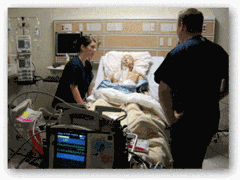This is becoming a hot topic and a hot item as well. Recently I have written about UC Irvine and Stanford University with their simulation hospital environments to  include simulated patients too.
include simulated patients too.
Patient Illness/Emergency Simulation at the Stanford University Goodman Center
One organization, Kaiser Permanente has been working with simulation for quite a while and pretty much includes every detail of a simulated hospital, all the way down to the janitor working in the area. Now that is paying attention to detail. You can read more about how the Garfield Center works at the link below when I had the opportunity a while back to chat with Chris McCarthy, head of their Innovation Department.
Innovation and Learning at Kaiser Permanente – Interview With Chris McCarthy
A couple months ago I wrote about defense contractors trying to find other resources for income and software is one of them.
Defense Contractors Focusing on Software Assets with Cut Backs With Defense Spending–More Health IT Software Houses
Here’s a good example with CMS giving Northrop Grumman the job of creating the “meaningful use” data base contract, to the tune of $34 Million. It makes you wonder though at times how much money could be saved if in house programmers and resources could be used too.
CMS Outsourcing Creation of “Meaningful Use” Database to Northrop Grumman in a $34 Million Contract
There are also private industry companies that offer this type of service and I am guessing contractors can incorporate some of this into their overall areas of responsibility for the contract given.
As the country's military simulation-and-training industry gathered in Orlando this week for its largest-yet trade show, one thing was clear: Defense contractors have civilian health-care sales in their crosshairs.
From combat-medic training to 3D virtual surgery, companies are hoping their military-training technology will soon translate to a vast, new marketplace: the nation's health-care system.
Many of their new simulation products are still in early stages, but defense contractors are pouring millions of dollars into research and development with the goal of capturing a share of the medical-technology market, industry officials said Wednesday.The local simulation industry has already reached out to Orlando's nascent "medical city," under development in the Lake Nona area. That cluster of biomedical and health-care facilities includes the Sanford-Burnham Medical Research Institute's East Coast lab and the University of Central Florida's College of Medicine.
The potentially lucrative health-care market is drawing the attention of big contractors such as Lockheed as well as scores of smaller businesses. Many of them hawked their wares this week in the trade show's Healthcare Pavilion — the first time the conference has showcased medical technology.




































We can understand the impact of Recession and Economic slowdown, Astonished to hear that defense companies are entering into the Civilian sector.
ReplyDelete